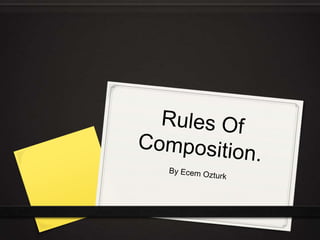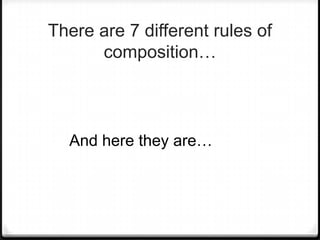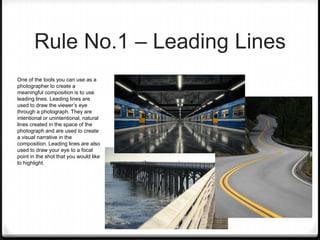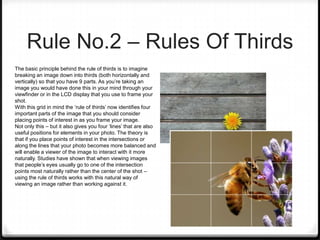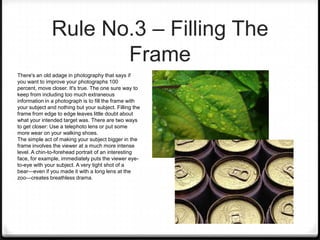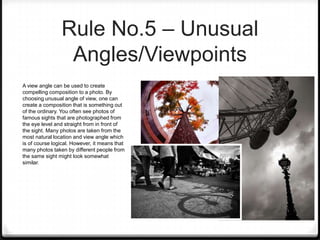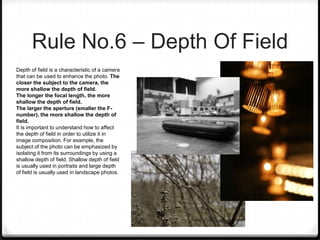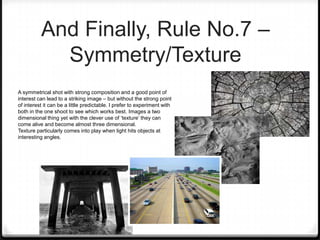Photography powerpoint
- 2. There are 7 different rules of composition… And here they are…
- 3. Rule No.1 – Leading Lines One of the tools you can use as a photographer to create a meaningful composition is to use leading lines. Leading lines are used to draw the viewer’s eye through a photograph. They are intentional or unintentional, natural lines created in the space of the photograph and are used to create a visual narrative in the composition. Leading lines are also used to draw your eye to a focal point in the shot that you would like to highlight.
- 4. Rule No.2 – Rules Of Thirds The basic principle behind the rule of thirds is to imagine breaking an image down into thirds (both horizontally and vertically) so that you have 9 parts. As you’re taking an image you would have done this in your mind through your viewfinder or in the LCD display that you use to frame your shot. With this grid in mind the ‘rule of thirds’ now identifies four important parts of the image that you should consider placing points of interest in as you frame your image. Not only this – but it also gives you four ‘lines’ that are also useful positions for elements in your photo. The theory is that if you place points of interest in the intersections or along the lines that your photo becomes more balanced and will enable a viewer of the image to interact with it more naturally. Studies have shown that when viewing images that people’s eyes usually go to one of the intersection points most naturally rather than the center of the shot – using the rule of thirds works with this natural way of viewing an image rather than working against it.
- 5. Rule No.3 – Filling The Frame There's an old adage in photography that says if you want to improve your photographs 100 percent, move closer. It's true. The one sure way to keep from including too much extraneous information in a photograph is to fill the frame with your subject and nothing but your subject. Filling the frame from edge to edge leaves little doubt about what your intended target was. There are two ways to get closer: Use a telephoto lens or put some more wear on your walking shoes. The simple act of making your subject bigger in the frame involves the viewer at a much more intense level. A chin-to-forehead portrait of an interesting face, for example, immediately puts the viewer eye- to-eye with your subject. A very tight shot of a bear—even if you made it with a long lens at the zoo—creates breathless drama.
- 6. Rule No.4 – Framing The Subject Framing is a technique used to enhance the overall result of a photo and to draw attention to the subject. Framing does not refer to physical frames you put your photos into. Compositional framing consists of using natural or man-made objects within the photo itself. There are endless choices when deciding on what to use as a frame, all you need is a little imagination and observation. When possible, a frame should correlate with the point of interest. For example, finding a gnarled piece of driftwood that’s been washed to shore would make an excellent natural frame for the ocean.
- 7. Rule No.5 – Unusual Angles/Viewpoints A view angle can be used to create compelling composition to a photo. By choosing unusual angle of view, one can create a composition that is something out of the ordinary. You often see photos of famous sights that are photographed from the eye level and straight from in front of the sight. Many photos are taken from the most natural location and view angle which is of course logical. However, it means that many photos taken by different people from the same sight might look somewhat similar.
- 8. Rule No.6 – Depth Of Field Depth of field is a characteristic of a camera that can be used to enhance the photo. The closer the subject to the camera, the more shallow the depth of field. The longer the focal length, the more shallow the depth of field. The larger the aperture (smaller the F- number), the more shallow the depth of field. It is important to understand how to affect the depth of field in order to utilize it in image composition. For example, the subject of the photo can be emphasized by isolating it from its surroundings by using a shallow depth of field. Shallow depth of field is usually used in portraits and large depth of field is usually used in landscape photos.
- 9. And Finally, Rule No.7 – Symmetry/Texture A symmetrical shot with strong composition and a good point of interest can lead to a striking image – but without the strong point of interest it can be a little predictable. I prefer to experiment with both in the one shoot to see which works best. Images a two dimensional thing yet with the clever use of ‘texture’ they can come alive and become almost three dimensional. Texture particularly comes into play when light hits objects at interesting angles.
